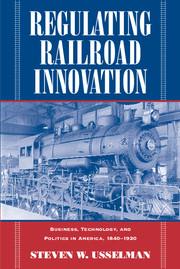Book contents
- Frontmatter
- Contents
- List of Illustrations
- Preface and Acknowledgments
- Introduction
- Part I ASSEMBLING THE MACHINE, 1840–1876
- Part II RUNNING THE MACHINE, 1876–1904
- Part III FRICTION IN THE MACHINE, 1904–1920
- 8 Reluctant Innovators: The Annoying Allure of Automatic Train Control
- 9 The Limits of Engineering: Rate Regulation and the Course of Innovation
- Epilogue: The Enduring Challenge of Innovation
- Index
8 - Reluctant Innovators: The Annoying Allure of Automatic Train Control
from Part III - FRICTION IN THE MACHINE, 1904–1920
Published online by Cambridge University Press: 12 August 2009
- Frontmatter
- Contents
- List of Illustrations
- Preface and Acknowledgments
- Introduction
- Part I ASSEMBLING THE MACHINE, 1840–1876
- Part II RUNNING THE MACHINE, 1876–1904
- Part III FRICTION IN THE MACHINE, 1904–1920
- 8 Reluctant Innovators: The Annoying Allure of Automatic Train Control
- 9 The Limits of Engineering: Rate Regulation and the Course of Innovation
- Epilogue: The Enduring Challenge of Innovation
- Index
Summary
During the last quarter of the nineteenth century, American railroads had at their disposal a variety of technological devices that held the potential to eliminate dangerous procedures performed by trainmen and other workers and in effect to automate the assembly and movement of trains through their systems. Automatic air brakes and couplers, which reduced dependence on brakemen in joining and stopping trains, had become standard features in passenger service by the mid-1870s. Established suppliers stood ready and eager to see them placed upon freight equipment. Inventors had also designed a variety of electromechanical appliances intended to activate signals automatically and link them to one another in switchyards and along the line. By the early 1880s, distinguished British firms and a number of domestic ones, including the recently formed Union Switch and Signal Company of George Westinghouse, offered railroads a full array of signaling devices and services.
Despite their apparent promise, however, none of these automatic devices gained widespread acceptance among those responsible for moving freight and passengers through the American railroad network. As discussed in Chapter 3, most railroads applied automatic brakes and couplers to passenger trains quite reluctantly, conceding to make the switch only under intense pressure from customers and from threatened legislation. Hand-operated brakes and couplers remained the norm in freight operations for more than another two decades, until federal legislation mandated the change to automatic devices at the start of the twentieth century. Automatic signaling met with similar resistance.
- Type
- Chapter
- Information
- Regulating Railroad InnovationBusiness, Technology, and Politics in America, 1840–1920, pp. 273 - 326Publisher: Cambridge University PressPrint publication year: 2002
- 1
- Cited by



